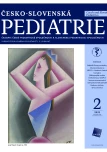Fetální magnetická rezonance – stručný přehled současného zobrazení a indikací
Authors:
Jayapal Praveen 1; Kyncl Martin 2; Rubesova Erika 1
Authors‘ workplace:
Department of Radiology, Lucile Packard Children‘s Hospital, Stanford University School of Medicine, Stanford, California, USA
; Department of Radiology, Second Faculty of Medicine, Charles University and Motol University Hospital, Prague, Czech Republic
2
Published in:
Čes-slov Pediat 2023; 78 (2): 91-95.
Category:
Review
doi:
https://doi.org/10.55095/CSPediatrie2023/013
Overview
Cíl: Autoři se v článku zabývají možnostmi vhodného zobrazení a nejčastějšími indikacemi k magnetické rezonanci u plodu.
Metody: Na příkladech klinických indikací k diagnostice pomocí magnetické rezonance jsou dokumentována orgánová specifika metody. Popsány jsou nejtypičtější systémově zaměřené indikace včetně nejběžnějších zobrazovacích technik. Nálezy jsou doplněny obrazovou dokumentací.
Výsledky: Magnetická rezonance má dnes důležité místo v prenatální diagnostice centrálního nervového systému i orgánů plodu, má úlohu v plánování postnatálního managementu.
Závěry: Fetální magnetická rezonance hraje klíčovou úlohu zejména při diagnostice složitějších onemocnění a anomálií plodu.
Klíčová slova:
indikace – fetální magnetická rezonance – zobrazování
Sources
1. Campbell S. A short history of sonography in obstetrics and gynaecology. Facts Views Vis Obgyn 2013; 5(3): 213–229.
2. Rubesova E, Barth R. Advances in fetal imaging. Am J Perinatol 2014; 31(07): 567–76.
3. Prayer D, Malinger G, Brugger PC, et al. ISUOG Practice Guidelines: performance of fetal magnetic resonance imaging. Ultrasound Obstet Gynecol 2017; 49(5): 671–80.
4. Colleran GC, Kyncl M, Garel C, Cassart M. Fetal magnetic resonance imaging at 3 Tesla — the European experience. Pediatr Radiol 2022; 52(5): 959–70.
5. Cassart M, Garel C. European overview of current practice of fetal imaging by pediatric radiologists: a new task force is launched. Pediatr Radiol [Internet]. 2020 Jun 18 [cited 2020 Oct 17]. Available from: http://link.springer. com/10.1007/s00247-020-04710-4
6. Coakley FV, Glenn OA, Qayyum A, et al. Fetal MRI: A developing technique for the developing patient. Am J Roentgenol 2004; 182(1): 243–52.
7. Barzilay E, Bar-Yosef O, Dorembus S, et al. Fetal brain anomalies associated with ventriculomegaly or asymmetry: An MRI-based study. AJNR Am J Neuroradiol 2017; 38(2): 371–5.
8. Tocchio S, Kline-Fath B, Kanal E, et al. MRI evaluation and safety in the developing brain. Seminar Perinatol 2015; 39(2): 73–104.
9. Saleem SN. Fetal MRI: An approach to practice: A review. J Adv Res 2014; 5(5): 507–23.
10. Niemiec SM, Louiselle AE, Phillips R, et al. Third-trimester percentage predicted lung volume and percentage liver herniation as prognostic indicators in congenital diaphragmatic hernia. Pediatr Radiol [Internet]. 2022 Oct 27 [cited 2022 Nov 13]. Available from: https://link.springer.com/10.1007/ s00247-022-05538-w
11. Barth RA. Imaging of fetal chest masses. Pediatr Radiol 2012; 42(S1): 62 – 73.
12. Alamo L, Meyrat BJ, Meuwly JY, et al. Anorectal malformations: finding the pathway out of the labyrinth. RadioGraphics 2013; 33(2): 491–512.
13. Victoria T, Jaramillo D, Roberts TPL, et al. Fetal magnetic resonance imaging: jumping from 1.5 to 3 tesla (preliminary experience). Pediatr Radiol 2014; 44(4): 376–86.
Labels
Neonatology Paediatrics General practitioner for children and adolescentsArticle was published in
Czech-Slovak Pediatrics

2023 Issue 2
Most read in this issue
- Myokarditidy a kardiomyopatie
- Prenatální diagnostika ovariálních cyst, management a výsledky těhotenství
- Příprava dítěte před vyšetřením magnetickou rezonancí
- Současné možnosti farmakoterapie dětské obezity
